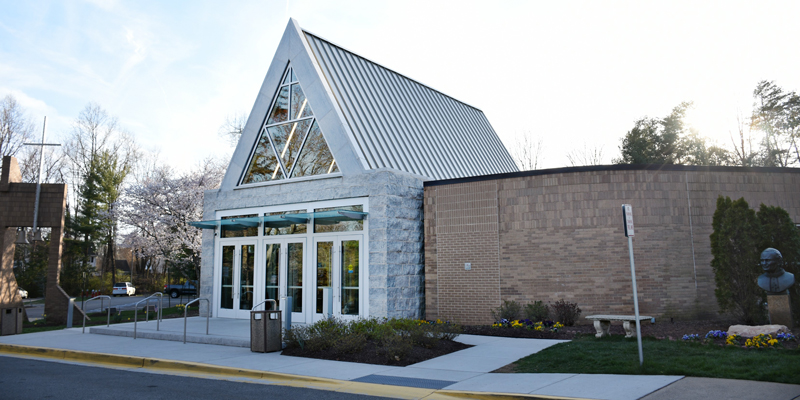
Founding Pastor: Rev. Frank Ready
Parish Founded: The parish held its first Mass on June 11, 1973, at Hunt Valley Elementary. Then, on July 1, 1973, it received its official name, Church of the Nativity. In February 1974, a building fund was established for the new parish, and later that summer, 10.4 acres of land were purchased on Old Keene Mill Road in Burke. A groundbreaking for the new building was held on June 11, 1977, and Bishop Thomas Welsh celebrated the first Mass in the new building on Friday, October 12, 1979, at 7:30 p.m.
Church Dedication: The formal dedication of the church was held on April 26, 1980, with Bishop Welsh presiding.
What Makes This Parish Unique?
“We at Nativity reach out to those in need across the street and around the world.” -Fr. Richard Martin, former pastor.
"I believe that what makes us unique is our outreach. Across all our parish organizations, we have a common charism of engaging with the poor and marginalized. We serve those in need outside the doors of the church building, and, by focusing on the needs of others, we bring ourselves to a more spiritual and joyful place. As Fr. Bob [Cilinski] says, 'A parish that reaches out to those in need becomes more generous overall.' Our growth and our joyful spirit come from serving others, not serving ourselves." -Jim McDaniel, parishioner
School Information:
Nativity Catholic School
Founded: 1996
Founding Pastor: Rev. Salvator Ciullo
The Felician Sisters, a community founded by Blessed Angela Truszkowska, responded to the invitation to staff Nativity Catholic School. On July 19, 1996, Sr. Lisa Marie DiSabatino, Principal, and Sr. Marie Victoria, Pastoral Minister, arrived in Burke. On August 16, 1996, Sr. Therese Marie Bednarczyk arrived to teach in the school. The doors of Nativity Catholic School opened for the first time on August 26, 1996.
Parish History:
The need for a new parish to serve this region of the county was becoming increasingly apparent as the population of Fairfax County exploded during the quarter century following the end of World War II. For most of its history, Fairfax had been an agricultural county whose farms provided food for Washington, Arlington County and the nearby City of Alexandria. From a population of slightly more than 12,000 in 1790, Fairfax County had grown to only 40,000 by 1940, on the eve of World War II. By 1950, though, its population neared 100,000; by 1960, it neared 250,000; by 1970, it exceeded 450,000. As subdivisions in the eastern part of the county filled with new families, there was increasing pressure to move south and west into areas that were still working farms. In the late 1960s into 1970, many Catholics living in the Orange Hunt and Rolling Valley communities felt isolated from their parish church. They had to travel a considerable distance to attend Mass or for weddings or baptisms. Some were even confused about the parish to which they belonged and attended Mass at Saint Bernadette Church instead. The situation was untenable from the perspective of Saint Mary of Sorrows Church as well. The tiny church, built in 1858 and now a national historic landmark, could barely handle the nearby parishioners; when the Orange Hunt and Rolling Valley parishioners were added, the small church overflowed during Mass.
Shortly after a door-to-door census to count the Catholics living in two neighborhoods, Saint Mary of Sorrows began celebrating Mass for these neighborhoods at the elementary school that serviced them: Hunt Valley Elementary. The school soon came to be referred to by parishioners as “Holy Hunt.” On June 11, 1973, the day Bishop Sullivan announced the creation of the new parish, Fr. Richard Farrell, co-pastor of Saint Mary of Sorrows, wrote the Fairfax County School Board to request that the new parish be allowed to use the Hunt Valley School until its worship center had been completed. Thus, when the parish's new pastor, Fr. Ready, arrived to celebrate the parish's first Mass on June 11, he found a congregation and a worship location (albeit temporary) already in place. Everything had happened so fast, however, that the new parish did not even have a name, and everyone temporarily referred to it as "St. What's-His-Name's Parish." One of the first orders of business was to select a name. Fr. Ready proposed and Bishop Sullivan accepted "Church of the Nativity," and on July 1, 1973, Fr. Ready informed the congregation not to use the temporary, informal term any longer. Nativity Parish was a reality.
To learn more about Nativity Catholic Church, visit https://nativityburke.org/.